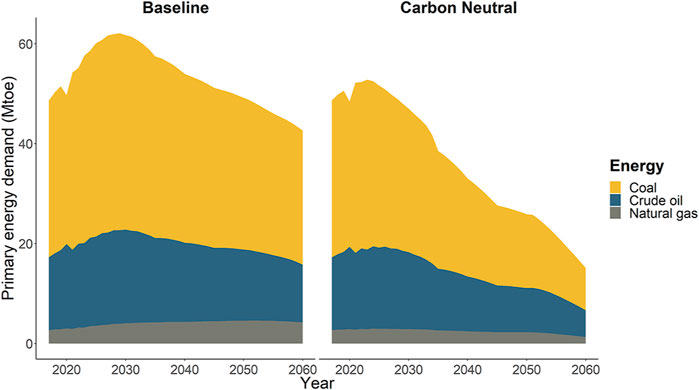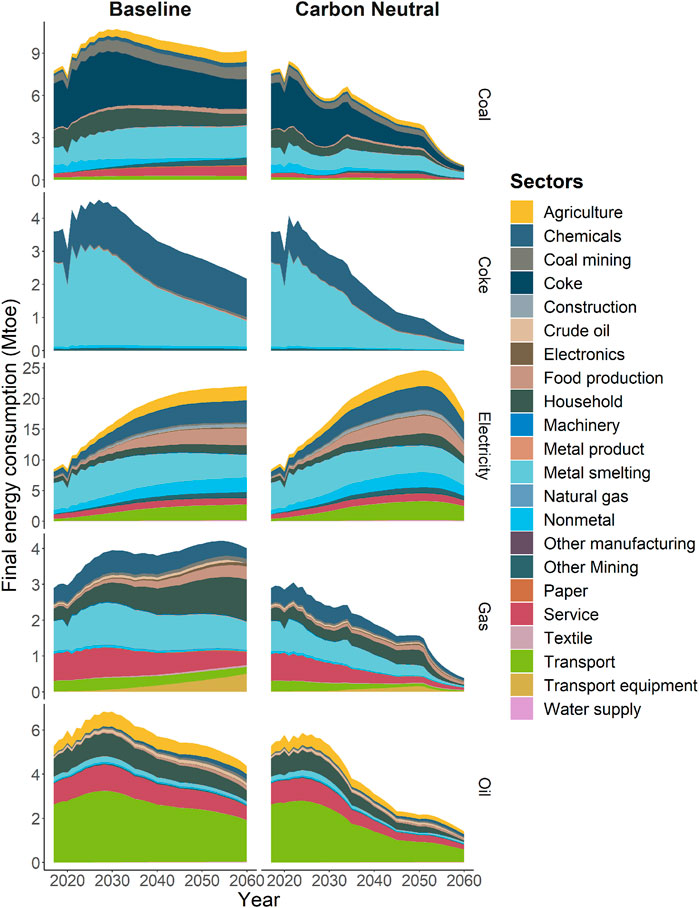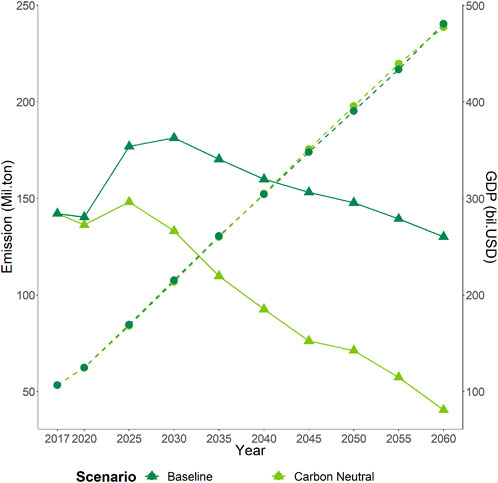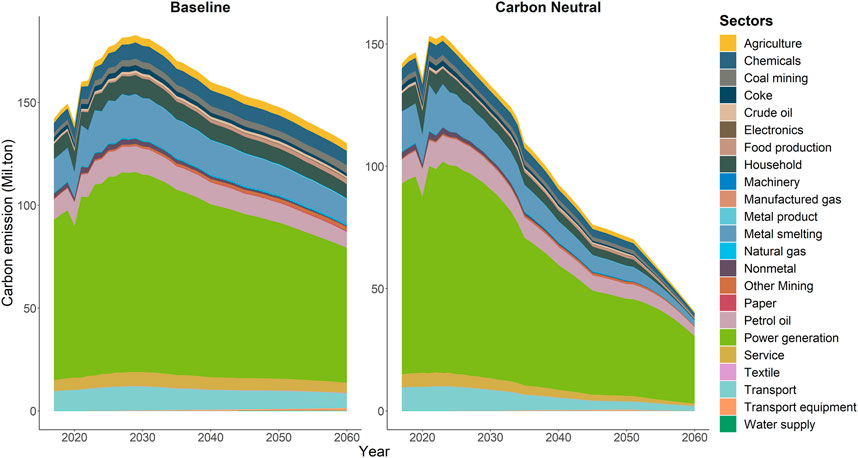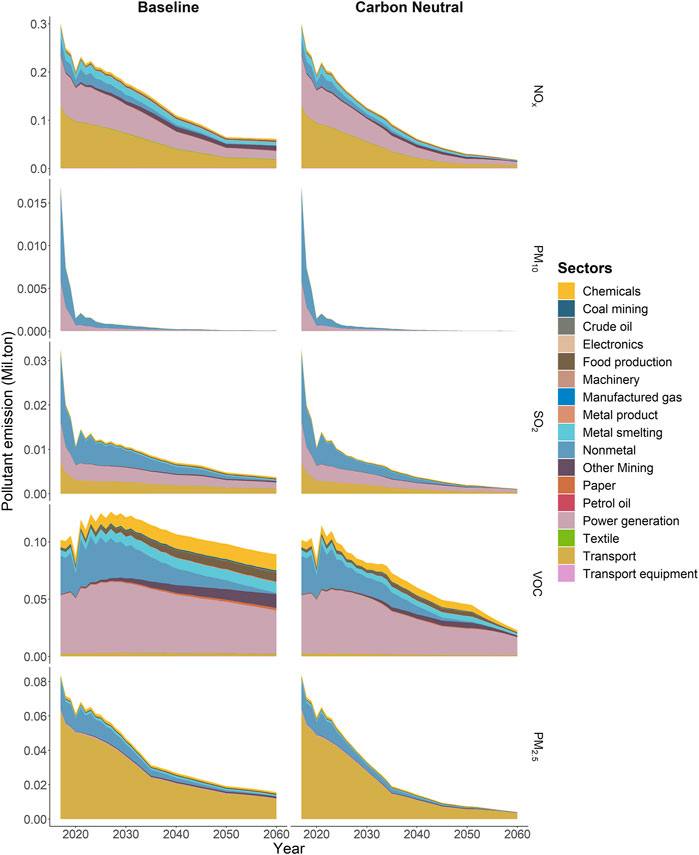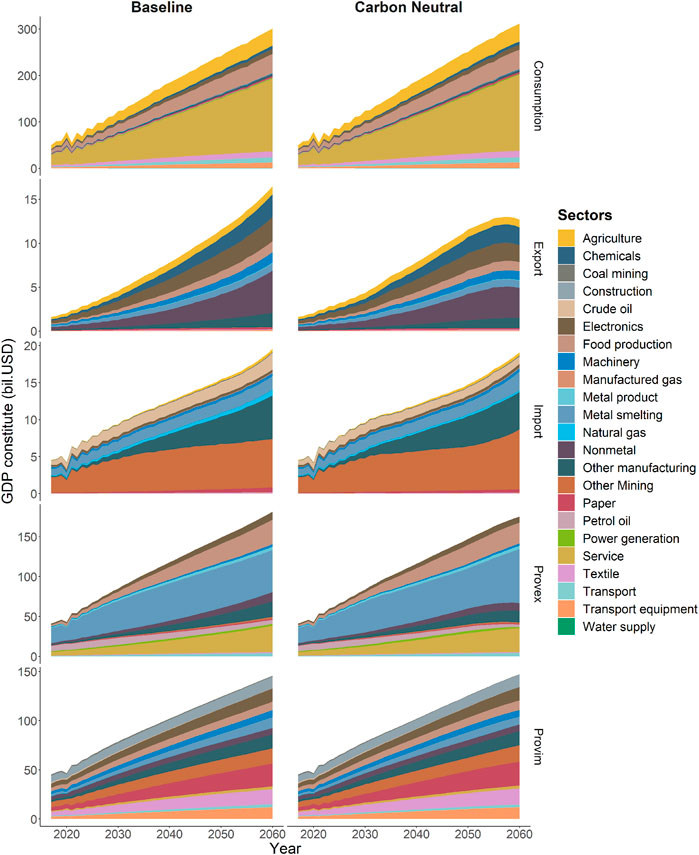- 1School of Public Health, Lanzhou University, Lanzhou, China
- 2Gansu Provincial Center for Disease Control and Prevention, Lanzhou, China
- 3College of Environmental Sciences and Engineering, Peking University, Beijing, China
Gansu province will fulfill the carbon reduction target under the national carbon neutrality strategy. As a developing province in China, Gansu will have to trade off carbon reduction targets and economic development. This study adopts a computable general equilibrium model to simulate the carbon reduction pathway and estimate the possible impacts on the economy, output and environment under a carbon-neutral target. Our results show carbon emission will peak around 2033 in the baseline scenario and decline slowly after the peak. While carbon emissions will peak around 2023 in the carbon neutral scenario and decline very fast from 154 million tons in 2023 to 40 million ton in 2060. The economy will continue to increase from 734 billion CNY in 2017–3375 billion CNY in 2050 under a carbon reduction target, which means the carbon neutral target will have very limited economic impacts by 2060. At the sector level, economic outputs vary among different sectors. The output will increase significantly, such as power generation 14%, water supply 8% and nonmental 4%. Some other sectors will decrease quickly, paper 15% and textile industry 7%. Carbon reduction will also contribute to air pollutants reduction, which is a benefit to air quality. Carbon neutral targets will bring more opportunities in Gansu due to green energy potential without economic burden. Proper carbon mitigation policy would avoid the adverse impact but bring more potential to the economy in Gansu.
Introduction
Climate change is one of the biggest challenges to the world today, and addressing climate change has become a major issue for all countries (Cai et al., 2021; Romanello et al., 2021; Watts et al., 2021; Cai et al., 2022). In response to climate change, the Paris Agreement, signed by the international community in 2015 (Zhou et al., 2021; Ekardt and Development, 2022), requires countries to keep the global average temperature rise below 2°C and work towards limiting it to 1.5°C above the pre-industrial level (IPCC, 2021; O'Neill et al., 2017). To address the global climate crisis, China intended to fulfill a new Nationally Determined Contribution (NDC) target (Timilsina et al., 2018), which aims to reach peak carbon dioxide emissions by 2030 and achieve carbon neutrality by 2060 (Zhang and Chen, 2022). China has actively participated in global governance through measures such as industrial structure adjustment (Zhu et al., 2019; Xiao et al., 2021), energy structure optimization (Liu et al., 2019), and energy efficiency improvement (Zhang et al., 2015; Zhang et al., 2020). In 2019, China achieved its nationally determined contribution to climate change 2020. Compared with 2005, the carbon emission intensity has dropped by 48.1%, and the proportion of fossil fuels in total primary energy consumption has decreased by 15.3% (Zhao et al., 2021). However, provinces and regions differ significantly in economic development, energy consumption, carbon emissions, and many other aspects, and thus the pathways to achieving carbon neutrality goals vary considerably across regions and sectors. The formulation and implementation of specific carbon emission reduction policies for different regions are of great significance to the smooth realization of the carbon neutrality goal (Xie et al., 2020).
Many studies have predicted carbon emissions pathways under carbon neutrality targets at the national level and regional levels. Zhang et al. assessed the energy transition in China towards carbon neutrality. They found that if emissions peak in 2025, the carbon neutrality goal calls for a 45–62% electrification rate, 47–78% renewable energy in the primary energy supply, and 64–1,649 MtCO2 of negative emissions, and synergistically reducing approximately 80% of local air pollutants compared to the present level in 2050 (Zhang and Chen, 2022). Zhuo et al. found that the electricity supply costs would increase by 9.6 CNY/kWh in China, and the major cost shift would result from the substantial investments in RE capacities, flexible generation resources, and network expansion (Zhuo et al., 2022). In Beijing-Tianjin-Hebei region, Wu et al. assessed the co-benefit pathway for achieving both the carbon neutrality target and Beautiful China goal and found significant mutual effects of CO2 emission mitigation and air pollution reduction (Wu et al., 2022). Liu et al. estimated the decarbonization benefits on air pollution in Guangdong-Hongkong-Macao Greater Bay Area and found that the transport sector has the most significant potential for carbon reduction. At the same time, energy intensity and structural transformations are the main contributors to reducing carbon emissions, with the latter becoming increasingly important over time (Liu et al., 2022a). Most of these existing studies focused on the national level or developed regions.
Gansu Province, located in western China, is one of the less economically developed provinces with relatively underdeveloped industries and a high dependence on traditional fossil energy (Dong et al., 2015; Xin et al., 2021). Gansu is also one of the promising provinces with the potential for a higher economic growth rate in the coming decades, meaning energy demand will increase rapidly. Hence, achieving a carbon reduction target while maintaining economic growth will be a major challenge for Gansu. Recently, several studies have been conducted on the driving forces and trend forecasting of carbon emissions in Gansu Province. The influence of various factors on the change of CO2 emissions in Gansu Province varies significantly. Li et al. found that Gansu had relatively low industrial CO2 emissions compared to other provinces, with the primary contributing emissions from coal products (Li et al., 2017). In addition, CO2 emissions per capita in Gansu Province have grown slowly over the past 2 decades. In the future, however, the expansion of the economic scale will play a decisive role in the growth of CO2 emissions, while the secondary industry is the largest emitter of carbon (Li et al., 2017). The cumulative growth of CO2 emissions in Gansu Province is 20.20%, driven mainly by industrial structure, population size, and energy structure, whose cumulative contribution rates were 9.68%, 7.81%, and 3.05%, respectively (Xin et al., 2021). From another perspective, Gansu is one of the provinces with abundant renewable energy. Large-scale development of renewable energy can massively reduce local carbon emissions while increasing the output of the power sector and improving the potential for clean energy exports to areas with higher energy demand. Under that circumstance, Gansu’s economic development will get a long-term boost (Zhou et al., 2022).
However, most of the existing studies on the pathways to achieve carbon neutrality focus on the national level or some developed provinces or cities in the east of China, such as Beijing-Tianjin-Hebei, Yangtze River Delta (Wu et al., 2016), Pearl River Delta (Cheng et al., 2016). Few studies simulated or systematic analyzed the possible carbon emission pathways in those west provinces. Meanwhile, these studies used input-output method and did not reflect the most recently released carbon neutrality targets at the provincial-level. To further explore the feasible pathways and impacts of achieving the carbon peak and neutrality target in Gansu province, this study firstly adopts IMED|CGE model in the following objectives: to simulate carbon emission reduction under different scenarios, estimate the macroeconomic impacts and output changes of achieving the low-carbon transition goal by sectors, and assess the co-benefits of carbon reduction on air pollutants reduction.
Materials and methods
IMED|CGE
This study uses the IMED|CGE developed by the Laboratory of Energy Environmental Economics and Policy (LEEEP) of Peking University. IMED|CGE model can flexibly adjust the base year, regional, and industry classification according to the specific research purpose and content. In this study, 2017 was selected as the base year and dynamically simulated in one-year steps up to 2060. The model contains 41 sectors, which are divided into the sector, resource demand sector, land demand sector, and energy supply sector. In addition, the model fully considers technology pathways to describe energy supply technologies such as power supply technology, non-fossil fuel supply technology, and carbon capture and storage (CCS) technology, which allows the model to more reasonably assess the cost of carbon abatement. Similar to most CGE models, IMED| CGE solves general equilibrium problems year-by-year through a mathematical programming system under the General Algebraic Modeling System (GAMS/MPSGE) (Rutherford, 1999). The model consists of four modules: the production module, the market module, the income module for government and households, and the expenditure module for final demanders. Sectoral activities are represented by a nested constant elasticity of substitution (CES) production function, where inputs are divided into materials, energy commodities, labor, capital, and resource inputs. IMED|CGE model has been widely used in our previous studies.
Scenarios setting
This study will simulate different pathways for achieving carbon peak and neutrality under various scenarios and estimate the potential impacts. Table 1 shows the parameter settings in IMED|CGE model, including GDP, population, and investment in Gansu provinces. For example, in the base year of 2017, Gansu province has a population of 26 million people, a GDP of 102 billion USD, and a per capita disposable income of 3,813 USD. Gansu is a province dominated by heavy industry, and its economic growth is mainly at the cost of high energy consumption. In 2017, Gansu Province consumed 0.99 tons of standard coal for 10,000 CNY GDP, emitted 151 million tons of CO2, accounting for 2.1% of national CO2 emissions, and 90 million tons of exhaust gas.
The socio-economic driving assumptions in IMED|CGE model, including population growth rate, total factor productivity (TFP), and autonomous energy efficiency improvement rate, are mainly based on the 13th Five-year Plan, 14th Five-year Plan, and mid-to long-term plan to 2060. Based on the future assumption, the economic growth rate will slow down after 2031, and the population growth rate in Gansu will decline from 2031. The baseline scenario assumes a 2% annual removal rate of air pollutants based on technological improvements and legislative requirements. Carbon emissions related to energy combustion are calculated using the emission coefficient recommended by IPCC, (2021), while emissions from industrial processes are assumed to be proportional to activity levels across China (e.g., steel production). This study’s process-related emissions were derived from EDGAR 4.1 emissions inventory data, with 2005 as the base year. Social-economic parameters, including economic growth rate, population growth, and technology data, are described in our previous study (Liu et al., 2022b).
We propose two scenarios to simulate the possible carbon emission trends and potential impacts with or without intensive carbon reduction targets (Table 2).
Baseline scenario: Future socio-economic development will continue according to the existing path and trend of NDC target. There is no intensive carbon reduction policy in China and Gansu province. Carbon emissions will continue to grow without the stringent carbon reduction target, except for the carbon reduction caused by technological progress. There is no additional policy cost on carbon reduction. Energy demand will increase fast and output in each sector will also follow the exsiting path.
Carbon Neutral Scenario: A policy scenario for deep carbon emission reduction, aiming to achieve the carbon peak in 2030 and carbon neutrality in 2060. Based on China’s carbon emission reduction potential, Carbon Neutral Scenario estimates the total carbon emissions allowed for Gansu Province to achieve the carbon neutrality target by 2060, which is based on the principle of per capita emission convergence. The historic data from 2011–2020 were calibrated with 2017 as the base year and 2060 as the target year.
Result
Future energy demand projection
The primary energy demand in China and Gansu province will continue to rise until 2030 under the baseline scenario. In contrast, it will decline sharply after peaking in 2023 under the carbon-neutral scenario. Figure 1 shows that primary energy demand in Gansu will rise to 61 Mtoe by 2029 in the baseline scenario and 51 Mtoe by 2025 in the carbon neutral scenario and decline to 42 Mtoe in the baseline scenario and 15 Mtoe in the carbon neutral scenario by 2060. In the base year of 2017, coal, crude oil and natural gas are 31 Mtoe, 14.6 Mtoe and 2.7 Mtoe, respectively. In the baseline scenario, coal will increase rapidly to 39 Mtoe in 2030 and decline to 27 Mtoe in 2060, crude oil will increase to 19 Mtoe in 2030 and slightly decline to 12 Mtoe in 2060. The demand for nature gas will slightly reach 4.3 Mtoe in 2060. However, in the carbon neutral scenario, the total fossil fuel demand will largely decline from 2017 to 2060. From each category perspective, demand for coal is expected to decline the most for 22.9 Mtoe from 2017 to 2060. Crude oil will likely increase from 14.6 Mtoe in 2017 to 16.3 Mtoe in 2050, decreasing quickly to 5.3 Mtoe in 2060. Nature gas will be stable from 2017 to 2030 and will have only 1.3 Mtoe left in 2060.
The share of each energy type changes slightly throughout the time interval in the baseline scenario. For example, the share of coal demand in primary energy is 64% in 2017, 63% in 2029, and 62% in 2060. The share of crude oil remains essentially unchanged. Only natural gas increases gradually over time, from 5.5% in 2017, 6.4% in 2029, to 10% in 2060. Under the carbon neutral scenario, the share of coal in primary energy demand will decline to 65% in 2023 and 55% in 2060.
The total final energy demand in China will increase under both the baseline and carbon neutral scenarios but will be much faster in the baseline scenario, from 2.1 to 3.6 billion toe from 2017 to 2060, whereas 2.3 billion toe in 2060 for carbon neutral scenario (Table 3). As for Gansu province, final energy demand will rise from 28 million toe in 2017 to 42 million toe in 2060 under the baseline scenario and reduce to 21 million toe by 2060 under the carbon neutral scenario. Figure 2 presents the final energy consumption by sector and by energy from 2017 to 2060 under the two scenarios. Results show that in both scenarios, there will be a continuous ascending trend in electricity demand from 9.6 million toe in 2017 till 2051. Under the carbon neutral scenario, it is expected to increase up to 25.9 million toe by 2051, slowly declining to 18.3 million toe in 2060. In contrast, the baseline scenario will rise from 9.6 to 22.5 million from 2017 to 2060.
On the one hand, energy use in Gansu Province is gradually electrified, and the deep emission reduction has let to a corresponding increase in clean electricity consumption to a certain extent. On the other hand, coal and oil consumption show a downward trend in both scenarios, which further indicates a higher percentage of final clean energy. From an industry perspective, transportation is the major sector for oil consumption, and coal is mainly used in thermal power generation, and chemical and metal smelting industries. Under the baseline scenario, coal consumption will increase from 7.7Mtoe in 2017 to 9.2Mtoe in 2060, and oil will decline from 5.2Mtoe in 2017 to 4.3Mtoe in 2060. Under the carbon neutral scenario, coal and oil further decrease to 1.1Mtoe and 1.4Mtoe, respectively. Natural gas consumption shows an upward trend under the baseline scenario and a downward trend under the carbon neutral scenario. Natural gas is mainly used in metal smelting, household and service industries. Natural gas increases from 2.9Mtoe in 2017 to 4.0Mtoe in 2060 under the baseline scenario, decreasing to 0.4Mtoe in 2060 under the carbon neutral scenario.
However, the final energy consumption of oil has rebounded due to the impact of the COVID-19 epidemic in 2020. From an optimistic view, the decline in non-renewable energy use under the deep carbon neutral reduction scenario is much more significant than that in the baseline scenario. The deep emission reduction policy will force the reduction in fossil energy use in order to achieve the carbon peak and carbon neutrality goals faster. On the whole, the future final energy structure will experience a gradual transition from fossil energy (natural gas, oil, coal) to electricity. Compared with the baseline scenario, more significant reductions are looking forward in final energy consumption across various industries in Gansu, where electricity from renewable energy will become the dominant energy type. Although coal can still be the primary energy source in the short term, an early energy structure transition by reducing coal consumption is strongly recommended.
Carbon emissions pathways
Figure 3 shows the changes in CO2 emissions from 2017 to 2060 under two scenarios in Gansu Province. In both scenarios, carbon emissions will increase from 2017 and peak between 2023 and 2029. However, the peak emission is much higher in the baseline scenario than carbon neutral scenario. Under the baseline scenario, carbon emissions are estimated to maintain a growth trend from 2017 to 2029. They will reach a peak of 182 million tons in 2029, then slowly decline to 133 million tons in 2060. The total cumulative CO2 emissions reduction from the energy system shall be around 114 million ton to achieve the carbon peak target. In the carbon neutral scenario, strict carbon emission reduction policies not only lead to a substantial reduction in CO2 emissions but also result in an earlier peak around 2023 at 154 million tons; Afterwards, the emissions drop rapidly to 40 million ton by 2060. Compared with the baseline scenario, the carbon neutral scenario reduces emissions by 89.68 million tons in 2060, nearly 69% of total emissions.
CO2 emission reductions in each sector varies under the two scenarios in Gansu. Figure 4 exhibits that CO2 emissions in Gansu is mainly a decline in power generation, metal smelting, petroleum oil smelting, and the transportation sector in both scenarios. While in the baseline scenario, total CO2 emission reduction is only around 11.9 million tons from 2017 to 2060, and major emissions reduction industries are power generation with 12.3 million tons, metal smelting with 4.1 million tons, petrol oil with 2.1 million ton, and transportation with 2.3 million ton. In the carbon neutral scenario, cumulative total CO2 emission reduction will reach to 101 million tons, including 50 million ton in power generation, 14.2 million ton in metal smelting, 7.6 million tons in transportation, 6.8 million tons in household, and 6.1 million ton from petrol oil, which account for 84% of the total CO2 emission reduction in Gansu. More specifically, the contribution of CO2 emission reduction is 50% from power generation, 14% from metal smelting, 7.4% from transportation, 6.7% from the household, and 6.5% from petrol oil. Other sectors contribute little to the reduction, such as the agriculture and chemical sector, with 1.5% and 2.4%, respectively.
Air pollutant emissions
Carbon emissions reduction also brings co-benefit to air pollution reduction. Figure 5 shows the synergistic effects of air pollutants in Gansu under the carbon emission reduction constraints. In the baseline scenario, only SO2 emissions increase from 2017 to 2025 by 0.023 million tons (+23%) and slowly decrease after 2025. While NOx, PM2.5, PM10, and VOC emissions constantly decrease from 2017 to 2060 by 0.09 million tons (-30%) and 0.02 million tons (-64%), 0.016 million tons (-94%), and 0.024 million ton (-28%), respectively. SO2, NOx, PM2.5, PM10, and VOC emissions in 2060 will reduce by 0.013 million tons (-12%), 0.239 million tons (-80%), 0.029 million tons (-88%), 0.017 million tons (-99%), and 0.069 (-81%), respectively. In the carbon neutral scenario, due to energy structure and final energy demand changes, only SO2 emissions slightly increased from 2017 to 2025. After 2025, all the air pollutants are likely to drop sharply compared with baseline scenario. SO2, NOx, PM2.5, PM10, and VOC emissions are reduced by 0.004 million tons (-4%), 0.128 million ton (-43%), 0.023 million ton (-70%), 0.016 million tons (-96%), and 0.034 million tons (-40%), respectively. In general, the emissions across the entire time period of SO2, NOx, PM2.5, PM10, and VOC are expected to decrease by 0.078 million tons (-78%), 0.283 million tons (-94%), 0.032 Million tons (-97%), 0.017 million tons (-99%), and 0.080 million tons (-95%), respectively.
Contributions to air pollutants reduction are different among sectors. Figure 5 further presents the air pollutants emissions under different scenarios from a sectoral perspective. For SO2 emission, power generation, chemical and non-metal sectors are the major emission sources, accounting for about 90% of the emissions in 2017 in the baseline scenario, and 86% in 2025, and 60% in 2060, respectively. Under the carbon neutral scenario, the values are estimated to increase slightly to 91%, 90%, and 78% in 2017, 2025, and 2060 in power generation, chemical, and non-metal sectors, respectively, because the proportion in other sectors decreases faster. Transportation and power generation are the primary emissions sectors for NOX emissions, contributing approximately 78% of the total emissions in 2017 and 75% and 55% in 2025 and 2060, respectively, under the baseline scenario. The carbon neutral scenario further increases the values to 80% and 59% in 2025 and 2060, respectively. As for VOC emissions, transportation and non-metal are the dominant emissions sectors, producing nearly 94% of the total emissions in 2017 under the baseline scenario and 92% and 75% in 2025 and 2060, respectively. In the carbon neutral scenario, VOC emissions in the transportation and non-metal sectors in 2017, 2025, and 2060 grew to 94%, 93%, and 87%, respectively. The primary sources of PM10 emissions are power generation and non-metal sectors, accounting for about 96% of total emissions in 2017 under the baseline scenario and 95% and 70% in 2025 and 2060, respectively. While in a carbon neutral scenario, the ratios rise to 96%, 97%, and 99% in 2017, 2025, and 2060, respectively. For PM2.5 emission, power generation, transportation and non-metal are the leading sectors, which accounted for 95%, 93% and 68% of total emission in 2017, 2025, and 2060, respectively, under the baseline scenario; and for 94% in 2025 and 83% in 2060 under the carbon neutral scenario.
Economic development
The carbon neutrality target significantly reduces carbon dioxide and air pollutants emissions and generates subsequent economic impacts in Gansu. Overall in the baseline scenario, GDP in Gansu continues to grow from 107 billion USD in 2017, to 215 billion in 2030 and 481 billion USD in 2060, increasing 4.5 times with an average annual growth rate of 3.6% from 2017 to 2060. Per capita GDP will increase from 4,059 USD/person in 2017 to 19,424 USD/person in 2060, with an average annual growth rate of 3.7%. While in the carbon neutral scenario, GDP in Gansu is about 214 billion USD in 2030 and 477 billion USD in 2060, respectively, with an average annual growth rate of 3.5%; while the GDP per capita will reach 19,238 USD/person in 2060 under a 3.7% average annual increase. Our results indicate that deep emission reduction policies in Gansu will improve energy efficiency, significantly reduce primary energy consumption, and steadily strengthen GDP growth.
In terms of economic growth components, consumption growth and inter-provincial transfer in Gansu play a decisive role in medium and long economic growth. The continuous GDP growth under the baseline scenario is consistent with the carbon neutral scenario (Figure 6). Of all the components, consumption grew the fastest, from 50 billion USD in 2017 to 300 billion USD in 2060, with an average annual growth rate of 4.3%, and the service sector takes the highest share, increasing from 43% in 2017 to 52% in 2060. However, agriculture and food production increased slightly from 12% in 2017 to 14% in 2060. During the same time, the inter-provincial transfer is estimated to grow significantly from 41 billion USD to 181 billion USD, with an average annual growth rate of 3.5%. By 2060, metal smelting will account for 29%, followed by the service industry with 18% and the food production industry with 16%. Inter-provincial transfer increased from 45 billion USD in 2017 to 145 billion USD in 2060, with an average annual growth rate of 2.8%. In 2060, the paper industry takes up a maximum of 16%, followed by the textile and other mining industries, with 11% and 10%, respectively.
The sectoral output changes between the two scenarios in 2050 in Gansu Province are shown in Figure 7. The significant increase in output mainly involves energy production-related sectors, water supply, transportation equipment, chemicals, and food production. Power generation ranks first, with an increase of more than 14% in output. The water supply comes in second with a rise of 8%. In contrast, output growth in some sectors is below 5%, such as agriculture, transportation, and service. The most significant output reduction under the carbon neutral scenario is in the paper industry, with a reduction of approximately 15%, followed by the textile industry, with a decrease of about 7%. Other sectors observe an output declining trend of less than 5%, including other manufacturing, electronics, and machinery. Overall, implementing a carbon neutral policy does not harm economic development in Gansu Province compared to the baseline scenario. Instead, the net economic output is positive and likely to have a slight increase.
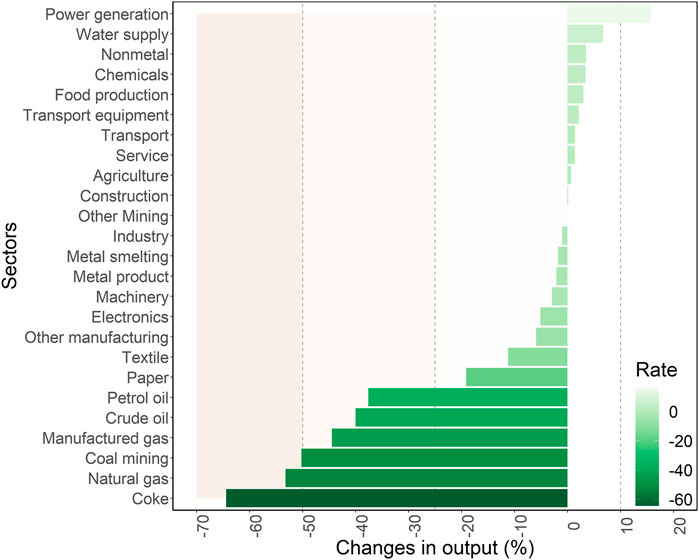
FIGURE 7. Output changes from the carbon neutral scenario to the baseline scenario in 2050 in Gansu.
Discussion and conclusion
This study applied the Integrated Model of Energy, Environment and economy for Sustainability Development (IMED|CGE) model to assess the impacts of achieving carbon neutrality goals on primary and final energy demand, carbon dioxide emissions, air pollutants emission, socio-economic development, and sectoral output. The results demonstrated that the carbon neutrality target would substantially reduce fossil energy consumption, carbon dioxide emissions and multiple air pollutants emissions in Gansu Province. Due to the unique natural endowments of Gansu and abundant renewable energy, the carbon neutrality target will not cause a negative impact on macroeconomic development. On the contrary, economic output has more significant potential for future growth in energy-related and water-supply industries. Other industries, such as non-metal, chemical, food production, transportation, and service industries, are also expected to observe a slight increase. Under the pressure of strict carbon restrictions, traditional industries such as paper, textile, and electronic manufacturing will see significant declines in the future.
Gansu must adjust a multi-objective optimization process to achieve the carbon neutrality target, including upgrading energy structure, increasing carbon emission limits, optimizing industrial structure, and improving energy efficiency. Additional efforts are needed in power generation, metal smelting, petrol oil, and transportation sectors to reduce carbon emissions. Under the carbon neutral pathway, an earlier peak will appear around 2023 at 154 million tons, and emissions will drop to 40 million tons by 2060 for a cumulative emission reduction of 114 million tons (74%).
As for macroeconomic impact, a strict carbon emission reduction policy in Gansu will bring co-benefit slightly, and more potential opportunities in low carbon sectors, such as the more abundant renewable energy, the more end-use clean energy, and larger output will continue in the power generation sector. As for environmental impact, the carbon neutrality target will synergistically lower air pollutants emissions. Compared with 2017, emissions of SO2, NOx, PM2.5, PM10, and VOC in 2060 shall be reduced from 78% to 99%. Air pollutants reduction will also improve air quality and bring health co-benefits to the public.
Gansu should seize its unique advantages and vigorously develop renewable energy by encouraging technological innovation, enhancing non-fossil energy targets, and stimulating clean energy investment and renovation in the power industry. It can promote economic development and employment opportunities in low-carbon industries in Gansu, export excess clean power to provinces with high energy demand and insufficient supply of clean energy, and improve the overall ecological environment and the sustainable development of society.
There are several limitations in our study. First, this study only estimated the emission reduction of carbon neutral target air pollutants but did not simulate the impacts on air quality in each scenario. Second, this study only considered two scenarios: baseline and carbon neutral. Carbon neutral target is one of the challenges for underdeveloped regions and more ambitious actions are needed in energy and industry restructuring. Another moderate scenario is needed for further policy assessment in Gansu Province.
Data availability statement
The raw data supporting the conclusion of this article will be made available by the authors, without undue reservation.
Author contributions
GZ, JS, and MX designed the study; GZ and MX performed the data analysis and visualization; WY, XL, and MX wrote the draft paper; XL, XL, YL provided the data and supervision.
Acknowledgments
Key Talent Project of Gansu Province in 2022(2022RCXM021).
Conflict of interest
The authors declare that the research was conducted in the absence of any commercial or financial relationships that could be construed as a potential conflict of interest.
Publisher’s note
All claims expressed in this article are solely those of the authors and do not necessarily represent those of their affiliated organizations, or those of the publisher, the editors and the reviewers. Any product that may be evaluated in this article, or claim that may be made by its manufacturer, is not guaranteed or endorsed by the publisher.
References
Cai, W., Zhang, C., Suen, H. P., Ai, S., Bai, Y., Bao, J., et al. (2021). The 2020 China report of the Lancet Countdown on health and climate change. Lancet. Public Health 6 (1), e64–e81. doi:10.1016/S2468-2667(20)30256-5
Cai, W., Zhang, C., Zhang, S., Bai, Y., Callaghan, M., Chang, N., et al. (2022). The 2022 China report of the lancet countdown on health and climate change: Leveraging climate actions for healthy ageing. Lancet Public Health. In press. doi:10.1016/s2468-2667(22)00224-9
Cheng, B., Dai, H., Wang, P., Xie, Y., Chen, L., Zhao, D., et al. (2016). Impacts of low-carbon power policy on carbon mitigation in Guangdong Province, China. Energy Policy 88, 515–527. doi:10.1016/j.enpol.2015.11.006
Dong, H., Dai, H., Dong, L., Fujita, T., Geng, Y., Klimont, Z., et al. (2015). Pursuing air pollutant co-benefits of CO 2 mitigation in China: A provincial leveled analysis. Appl. Energy 144, 165–174. doi:10.1016/j.apenergy.2015.02.020
Ekardt, F. J. E. S., and Development, P. (2022). Freedom, human rights, Paris agreement, and climate change: The German landmark ruling on climate litigation. Environ. Sci. Policy Sustain. Dev. 64 (2), 4–10. doi:10.1080/00139157.2022.2021791
IPCC (2021). Climate change 2021: The physical science basis. Contribution of working group I to the sixth assessment report of the intergovernmental panel on climate change. Cambridge, UK: Cambridge University Press.
Li, A., Zhang, A., Zhou, Y., and Yao, X. (2017). Decomposition analysis of factors affecting carbon dioxide emissions across provinces in China. J. Clean. Prod. 141, 1428–1444. doi:10.1016/j.jclepro.2016.09.206
Liu, C., Dai, H., Zhang, L., and Feng, C. (2019). The impacts of economic restructuring and technology upgrade on air quality and human health in Beijing-Tianjin-Hebei region in China. Front. Environ. Sci. Eng. 13 (5), 70. doi:10.1007/s11783-019-1155-y
Liu, X., Dai, H., Wada, Y., Kahil, T., Ni, J., Chen, B., et al. (2022). Achieving carbon neutrality enables China to attain its industrial water-use target. One Earth 5 (2), 188–200. doi:10.1016/j.oneear.2022.01.007
Liu, X., Guo, C., Ma, X., Wu, K., Wang, P., Huang, Z., et al. (2022). Uncovering the key mechanisms of how deep decarbonization benefits air pollution alleviation in China. Environ. Res. Lett. 17 (11), 115002. doi:10.1088/1748-9326/ac9746
O'Neill, B. C., Oppenheimer, M., Warren, R., Hallegatte, S., Kopp, R. E., Portner, H. O., et al. (2017). IPCC reasons for concern regarding climate change risks. Nat. Clim. Chang. 7 (1), 28–37. doi:10.1038/nclimate3179
Romanello, M., McGushin, A., Di Napoli, C., Drummond, P., Hughes, N., Jamart, L., et al. (2021). The 2021 report of the lancet countdown on health and climate change: Code red for a healthy future. Lancet 398 (10311), 1619–1662. doi:10.1016/S0140-6736(21)01787-6
Rutherford, T. F. (1999). Applied general equilibrium modeling with MPSGE as a GAMS subsystem: An overview of the modeling framework and syntax. Comput. Econ. 14 (1-2), 1–46.
Timilsina, G. R., Cao, J., and Ho, M. J. (2018). Carbon tax for achieving China’s NDC: Simulations of some design features using A CGE model. Clim. Chang. Econ. (Singap). 9 (03), 1850006. doi:10.1142/s2010007818500069
Watts, N., Amann, M., Arnell, N., Ayeb-Karlsson, S., Beagley, J., Belesova, K., et al. (2021). The 2020 report of the lancet countdown on health and climate change: Responding to converging crises. Lancet 397 (10269), 129–170. doi:10.1016/S0140-6736(20)32290-X
Wu, K., Liu, X., Dai, H., Zhang, S., Zhou, Z., Ma, T., et al. (2022). Mutual effects of CO2 emission reduction and air pollution control policies in beijing-tianjin-hebei region. Front. Environ. Sci. 10, 1791. doi:10.3389/fenvs.2022.1006142
Wu, R., Dai, H., Geng, Y., Xie, Y., Masui, T., and Tian, X. (2016). Achieving China’s INDC through carbon cap-and-trade: Insights from Shanghai. Appl. Energy 184, 1114–1122. doi:10.1016/j.apenergy.2016.06.011
Xiao, H., Zhou, Y., Zhang, N., Wang, D., Shan, Y., and Ren, J. (2021). CO2 emission reduction potential in China from combined effects of structural adjustment of economy and efficiency improvement. Resour. Conserv. Recycl. 174, 105760. doi:10.1016/j.resconrec.2021.105760
Xie, Y., Liu, X., Chen, Q., and Zhang, S. (2020). An integrated assessment for achieving the 2°C target pathway in China by 2030. J. Clean. Prod. 268, 122238. doi:10.1016/j.jclepro.2020.122238
Xin, L., Jia, J., Hu, W., Zeng, H., Chen, C., and Wu, B. (2021). Decomposition and decoupling analysis of CO2 emissions based on LMDI and two-dimensional decoupling model in Gansu province, China. Int. J. Environ. Res. Public Health 18 (11), 6013. doi:10.3390/ijerph18116013
Zhang, S., and Chen, W. J. N. (2022). Assessing the energy transition in China towards carbon neutrality with a probabilistic framework. Nat. Commun. 13 (1), 87–15. doi:10.1038/s41467-021-27671-0
Zhang, S., Worrell, E., and Crijns-Graus, W. (2015). Evaluating co-benefits of energy efficiency and air pollution abatement in China’s cement industry. Appl. Energy 147, 192–213. doi:10.1016/j.apenergy.2015.02.081
Zhang, S., Xie, Y., Sander, R., Yue, H., and Shu, Y. (2020). Potentials of energy efficiency improvement and energy–emission–health nexus in Jing-Jin-Ji’s cement industry. J. Clean. Prod. 278, 123335. doi:10.1016/j.jclepro.2020.123335
Zhao, G., Yu, B., An, R., Wu, Y., and Zhao, Z. (2021). Energy system transformations and carbon emission mitigation for China to achieve global 2 °C climate target. J. Environ. Manag. 292, 112721. doi:10.1016/j.jenvman.2021.112721
Zhou, D., Hu, F., Zhu, Q., and Wang, Q. J. R. (2022). Regional allocation of renewable energy quota in China under the policy of renewable portfolio standards. Resour. Conserv. Recycl. 176, 105904. doi:10.1016/j.resconrec.2021.105904
Zhou, S., Tong, Q., Pan, X., Cao, M., Wang, H., Gao, J., et al. (2021). Research on low-carbon energy transformation of China necessary to achieve the Paris agreement goals: A global perspective. Energy Econ. 95, 105137. doi:10.1016/j.eneco.2021.105137
Zhu, B., Zhang, M., Zhou, Y., Wang, P., Sheng, J., He, K., et al. (2019). Exploring the effect of industrial structure adjustment on interprovincial green development efficiency in China: A novel integrated approach. Energy Policy 134, 110946. doi:10.1016/j.enpol.2019.110946
Keywords: carbon neutrality, renewable energy, environmental pollution, gansu province, IMED|CGE
Citation: Xie M, Liu X, Yan W, Li Y, Liu X, Zhang G and Sun J (2022) Carbon emission reduction pathways under carbon neutrality targets in Gansu province of China. Front. Environ. Sci. 10:1042344. doi: 10.3389/fenvs.2022.1042344
Received: 12 September 2022; Accepted: 07 November 2022;
Published: 17 November 2022.
Edited by:
Jun Liu, University of Science and Technology Beijing, ChinaReviewed by:
Canying Zeng, Zhejiang University of Finance and Economics, ChinaZhixiong Weng, Beijing University of Technology, China
Copyright © 2022 Xie, Liu, Yan, Li, Liu, Zhang and Sun. This is an open-access article distributed under the terms of the Creative Commons Attribution License (CC BY). The use, distribution or reproduction in other forums is permitted, provided the original author(s) and the copyright owner(s) are credited and that the original publication in this journal is cited, in accordance with accepted academic practice. No use, distribution or reproduction is permitted which does not comply with these terms.
*Correspondence: Gexiang Zhang, emhhbmdneEBsenUuZWR1LmNu; Jianyun Sun, Mzc4OTQwOTIwQHFxLmNvbQ==
 Mingjun Xie
Mingjun Xie Xinyuan Liu3
Xinyuan Liu3 Wenshan Yan
Wenshan Yan Yongjun Li
Yongjun Li Xinwei Liu
Xinwei Liu Gexiang Zhang
Gexiang Zhang Jianyun Sun
Jianyun Sun

